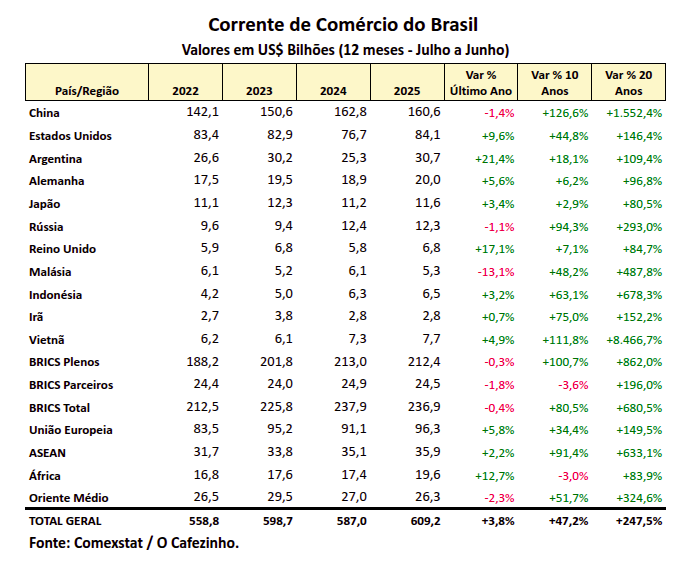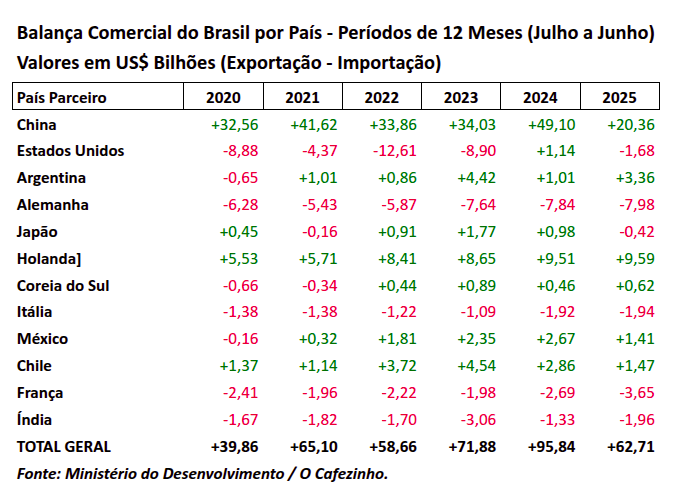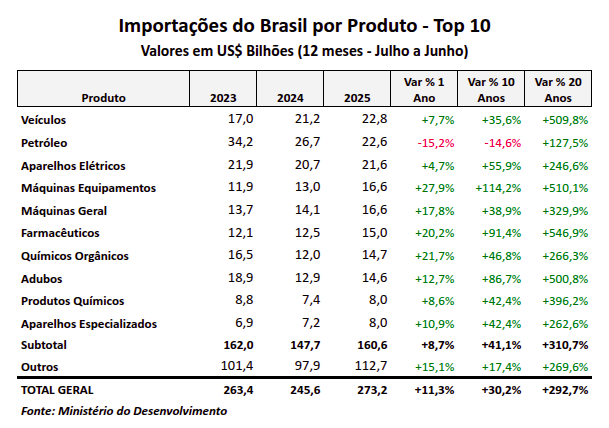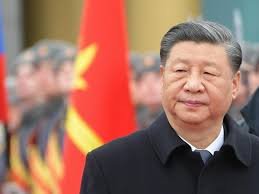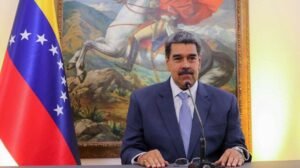
While Donald Trump once again threatens BRICS, Brazil solidifies its position on the global stage with a new historic record in foreign trade.
Data released today by the Ministry of Development reveal that Brazil’s trade flow (exports plus imports) over the last 12 months up to June reached US$ 609.2 billion.
The figures are impressive: 4% growth over the previous year, almost 50% in a decade, and a significant 250% in two decades. This performance reflects the expansion of Brazilian trade with practically all its major trading partners.
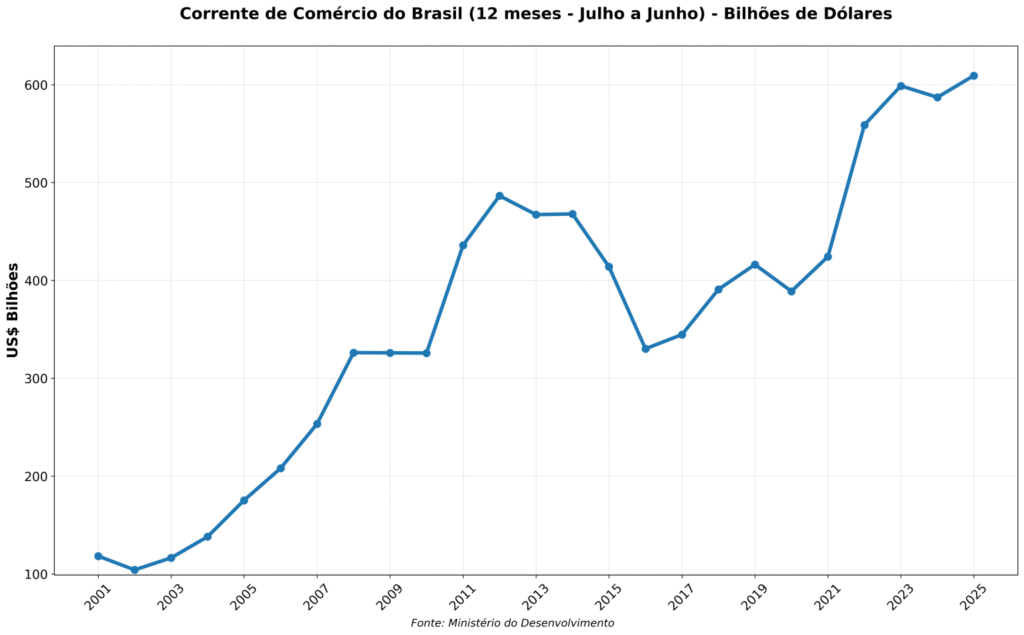
China Maintains Lead as Main Partner
China remains in the lead as Brazil’s main trading partner. In the last 12 months, bilateral exchange reached US$ 161 billion, registering a slight retraction of 1% compared to the previous period. However, this result represents the second-largest volume in the history of Sino-Brazilian trade relations.
The historical perspective reveals the magnitude of this partnership: 127% growth in ten years and an extraordinary 1,552% in two decades. Another Asian highlight is Vietnam, whose imports of Brazilian products are approaching US$ 8 billion, demonstrating an expansion exceeding 8,400% in twenty years.
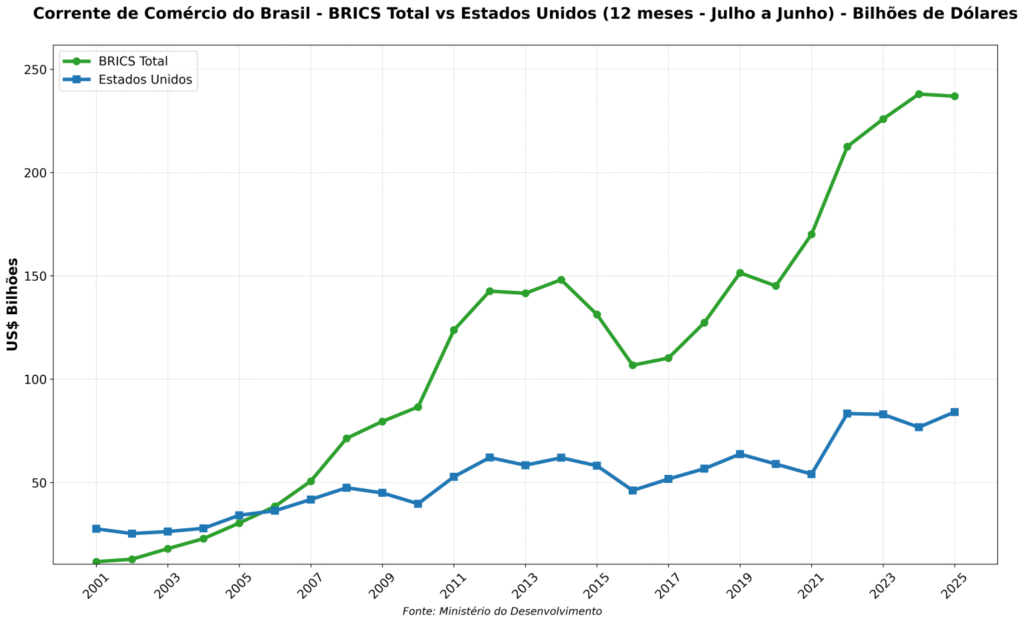
United States Intensifies Trade Relationship
Exports to the United States recorded robust growth of 10%. Bilateral trade reached US$ 84 billion, demonstrating that attempts at commercial isolation promoted by Bolsonarist sectors did not prosper.
The data highlight a pragmatic reality: the United States systematically expands its trade relationship with Brazil out of strategic necessity, not ideological preference.
BRICS Consolidates Strategic Position
The BRICS bloc countries currently represent 38.9% of Brazil’s trade flow, consolidating themselves as fundamental strategic partners. This participation reflects consistent growth over the last two decades: in 2001, the countries that today comprise BRICS accounted for only 9.8% of Brazil’s commercial exchange.
The Full BRICS – which include China, Russia, India, South Africa, Egypt, Ethiopia, Iran, United Arab Emirates, Saudi Arabia, and Indonesia – represent 34.9% of the total, while the Partner BRICS – Belarus, Bolivia, Kazakhstan, Cuba, Malaysia, Nigeria, Thailand, Uganda, Uzbekistan, and Vietnam – contribute 4.0%. This configuration demonstrates how Brazil has geographically diversified its trade relations, reducing dependence on traditional markets and strengthening ties with emerging and developing economies.
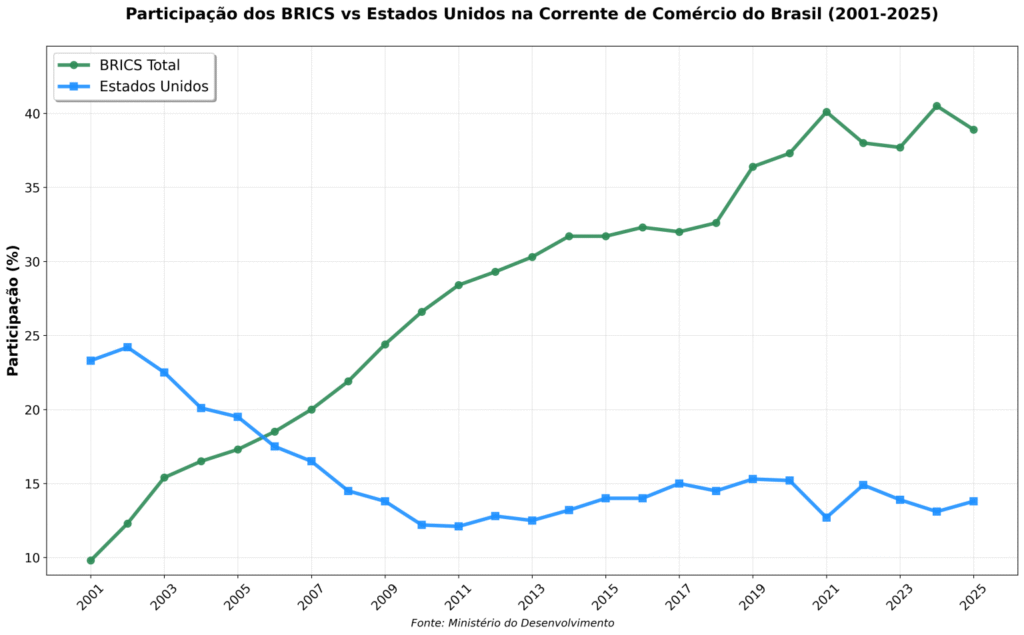
Africa Emerges as Promising Market
The African continent stands out as a frontier for commercial expansion. Brazilian exports to Africa advanced 13% in the last year, accumulating 84% growth in two decades. This movement consolidates the potential of South-South relations in Brazil’s trade strategy.
Trade Balance Shows Solidness
The trade balance surpassed US$ 60 billion in the last twelve months. Although lower than the record of almost US$ 100 billion in the previous period, this result does not reflect a weakness in exports, which remain at historic levels.
Brazilian external sales have consistently fluctuated between US$ 300 billion and US$ 340 billion in the last three years. The reduction in the trade surplus is due to the heating up of imports, signaling dynamism in the domestic economy.
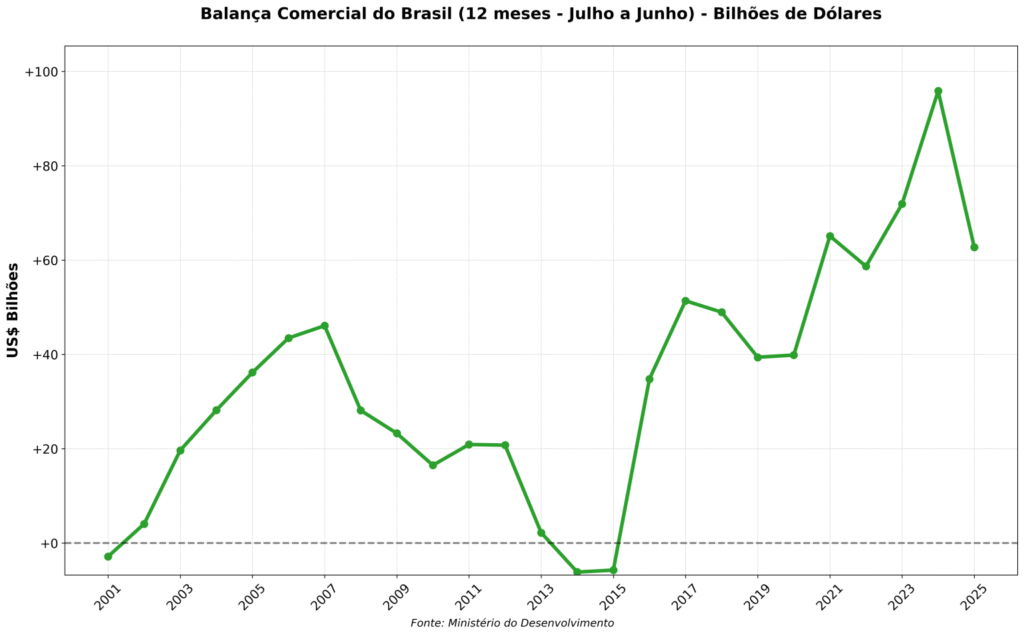
Imports Accelerate 11%
External purchases grew 11% in the period, driven by machinery and electrical equipment, industrial equipment, pharmaceuticals, and organic chemicals. This movement reflects both the modernization of the productive park and the addressing of the needs of the Brazilian population.
For emerging economies like Brazil’s, trade surpluses constitute a fundamental anchor for exchange rate stability, generating foreign currency and strengthening resilience to external crises.
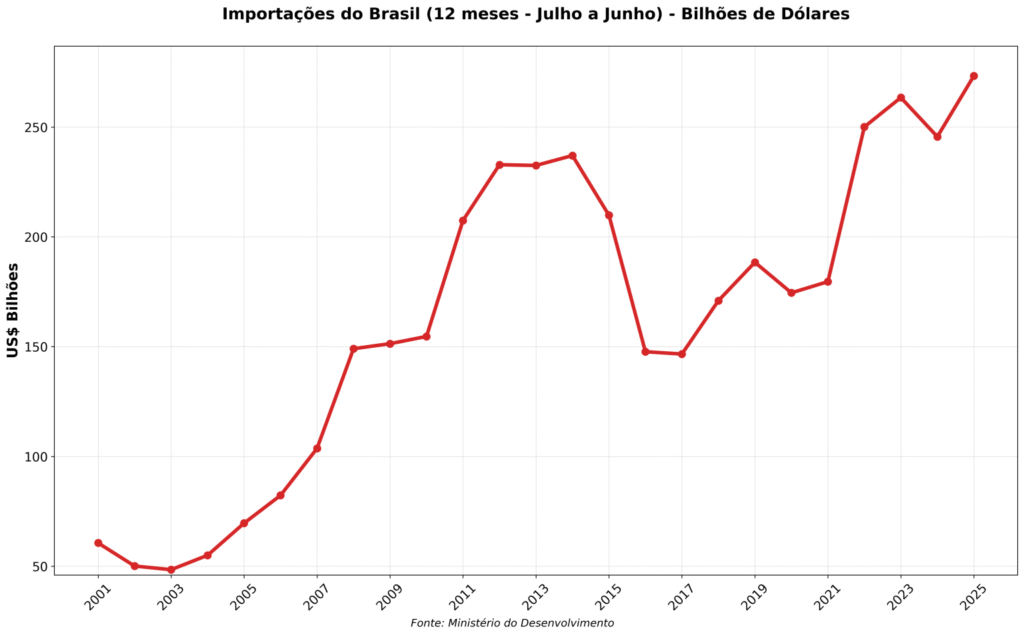

Diversified Export Agenda
Fuels led the list, with emphasis on oil and derivatives, followed by soybeans, iron ore, meats, and coffee.
Coffee deserves special mention: exports totaled US$ 16.3 billion, registering spectacular growth of 52% in one year, 111% in ten years, and 430% in two decades. The Brazilian grain reclaims its prominence in the national export agenda.
Other sectors also shone. Vehicles generated US$ 13.5 billion in revenue, setting new records. Steel remained above US$ 13 billion, resisting American tariff pressures. Cellulose contributed US$ 11 billion, consolidating Brazil as a powerhouse in the sector.
Leadership by Products
Oil tops the list with US$ 54 billion in exports, including crude oil and derivatives. Soybeans occupy the second position with US$ 41 billion, followed by iron ore with US$ 37 billion.
Meats set a new historic record by generating US$ 28 billion. Sugar completed the top 5 with US$ 16.3 billion, reaffirming the diversification of Brazil’s export agenda.
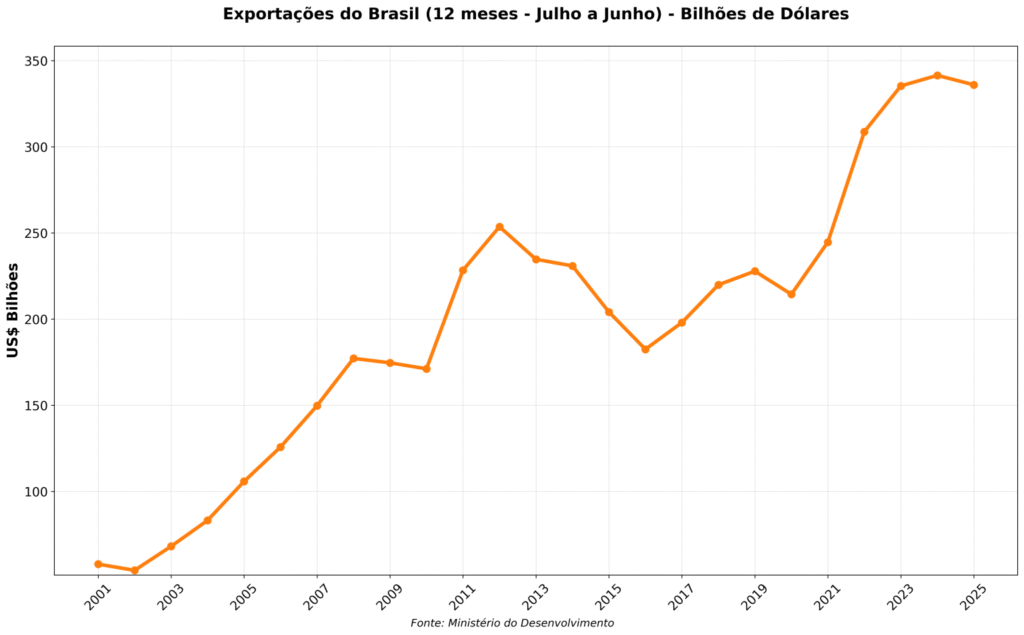
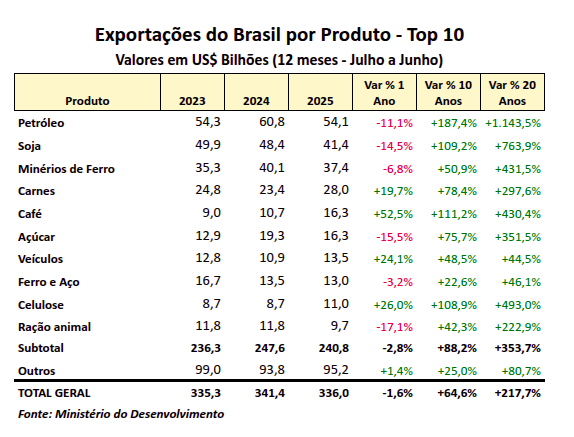
Trade Balances by Sector
In the analysis of trade balances, soybeans lead with US$ 41 billion, demonstrating the absolute competitiveness of Brazilian agribusiness. Iron ore registered US$ 36 billion, while oil reached US$ 31 billion.
It is worth noting that, although Brazil is a major oil exporter, it also imports significant volumes of diesel and other derivatives, explaining the difference between gross exports and net balance.
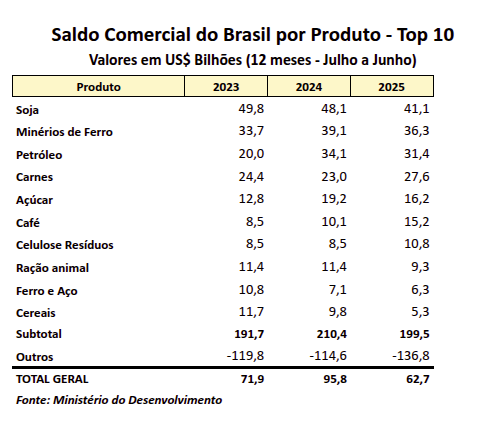
Optimistic Perspectives
Foreign trade indicators attest to the vigor of the Brazilian economy. Combined with the downward trajectory of inflation, these results signal favorable conditions to accelerate economic growth in 2025 and 2026.
